Related Research Articles

A space suit or spacesuit is a garment worn to keep a human alive in the harsh environment of outer space, vacuum and temperature extremes. Space suits are often worn inside spacecraft as a safety precaution in case of loss of cabin pressure, and are necessary for extravehicular activity (EVA), work done outside spacecraft. Space suits have been worn for such work in Earth orbit, on the surface of the Moon, and en route back to Earth from the Moon. Modern space suits augment the basic pressure garment with a complex system of equipment and environmental systems designed to keep the wearer comfortable, and to minimize the effort required to bend the limbs, resisting a soft pressure garment's natural tendency to stiffen against the vacuum. A self-contained oxygen supply and environmental control system is frequently employed to allow complete freedom of movement, independent of the spacecraft.

A shape or figure is the graphical representation of an object or its external boundary, outline, or external surface, as opposed to other properties such as color, texture, or material type. A plane shape or plane figure is constrained to lie on a plane, in contrast to solid 3D shapes. A two-dimensional shape or two-dimensional figure may lie on a more general curved surface.

Crumple zones, crush zones, or crash zones are a structural safety feature used in vehicles, mainly in automobiles, to increase the time over which a change in velocity occurs from the impact during a collision by a controlled deformation; in recent years, it is also incorporated into trains and railcars.

Barotrauma is physical damage to body tissues caused by a difference in pressure between a gas space inside, or in contact with, the body, and the surrounding gas or fluid. The initial damage is usually due to over-stretching the tissues in tension or shear, either directly by expansion of the gas in the closed space or by pressure difference hydrostatically transmitted through the tissue. Tissue rupture may be complicated by the introduction of gas into the local tissue or circulation through the initial trauma site, which can cause blockage of circulation at distant sites or interfere with normal function of an organ by its presence.
Stress–strain analysis is an engineering discipline that uses many methods to determine the stresses and strains in materials and structures subjected to forces. In continuum mechanics, stress is a physical quantity that expresses the internal forces that neighboring particles of a continuous material exert on each other, while strain is the measure of the deformation of the material.

A mechanical counterpressure (MCP) suit, partial pressure suit, direct compression suit, or space activity suit (SAS) is an experimental spacesuit which applies stable pressure against the skin by means of skintight elastic garments. The SAS is not inflated like a conventional spacesuit: it uses mechanical pressure, rather than air pressure, to compress the human body in low-pressure environments. Development was begun by NASA and the Air Force in the late 1950s and then again in the late 1960s, but neither design was used. Research is under way at the Massachusetts Institute of Technology (MIT) on a "Bio-Suit" System which is based on the original SAS concept.
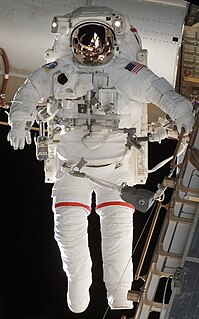
The Extravehicular Mobility Unit (EMU) is an independent anthropomorphic spacesuit that provides environmental protection, mobility, life support, and communications for astronauts performing extravehicular activity (EVA) in Earth orbit. Introduced in 1981, it is a two-piece semi-rigid suit, and is currently one of two types of EVA spacesuits used by crew members on the International Space Station (ISS), the other being the Russian Orlan space suit. It was used by NASA's Space Shuttle astronauts prior to the end of the Shuttle program in 2011.

A pressure suit is a protective suit worn by high-altitude pilots who may fly at altitudes where the air pressure is too low for an unprotected person to survive, even breathing pure oxygen at positive pressure. Such suits may be either full-pressure or partial-pressure. Partial-pressure suits work by providing mechanical counter-pressure to assist breathing at altitude.

ILC Dover, LP is a special engineering development and manufacturing company, globally headquartered in Newark, Delaware. ILC Dover specializes in the use of high-performance flexible materials, serving the aerospace, personal protection, and pharmaceutical industries.

The Mercury space suit was a full-body, high-altitude pressure suit originally developed by the B.F. Goodrich Company and the U.S. Navy for pilots of high-altitude fighter aircraft. It is best known for its role as the spacesuit worn by the astronauts of the Project Mercury spaceflights.

Soft-body dynamics is a field of computer graphics that focuses on visually realistic physical simulations of the motion and properties of deformable objects. The applications are mostly in video games and films. Unlike in simulation of rigid bodies, the shape of soft bodies can change, meaning that the relative distance of two points on the object is not fixed. While the relative distances of points are not fixed, the body is expected to retain its shape to some degree. The scope of soft body dynamics is quite broad, including simulation of soft organic materials such as muscle, fat, hair and vegetation, as well as other deformable materials such as clothing and fabric. Generally, these methods only provide visually plausible emulations rather than accurate scientific/engineering simulations, though there is some crossover with scientific methods, particularly in the case of finite element simulations. Several physics engines currently provide software for soft-body simulation.
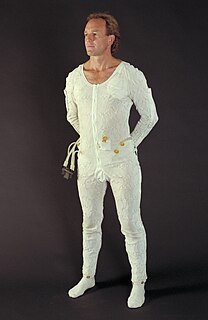
A liquid cooling garment (LCG) is a form-fitting garment that is used to remove body heat from the wearer in environments where evaporative cooling from sweating and open-air convection cooling does not work, or the wearer has a biological problem that hinders self-regulation of body temperature.
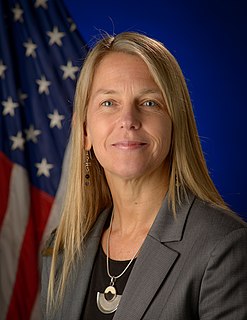
Dava J. Newman is the director of the MIT Media Lab and a former deputy administrator of NASA. Newman earned her PhD in aerospace biomedical engineering, and Master of Science degrees in aerospace engineering and technology and policy all from MIT, and her Bachelor of Science degree in aerospace engineering from the University of Notre Dame. Newman is the Apollo Program Professor of Aeronautics and Astronautics and Engineering Systems at the Massachusetts Institute of Technology and a member of the faculty at the Harvard–MIT Program in Health Sciences and Technology. She is also a MacVicar Faculty Fellow, former director of the Technology and Policy Program at MIT (2003–2015), and has been the director of the MIT Portugal Program since 2011. As the director of MIT's Technology and Policy Program (TPP), she led the institute's largest multidisciplinary graduate research program, with over 1,200 alumni. She has been a faculty member in her home department of Aeronautics and Astronautics and MIT's School of Engineering since 1993.
Science fiction authors have designed imaginary spacesuits for their characters almost since the beginning of fiction set in space.

David Clark Company, Inc. is an American manufacturing company. DCC designs and manufactures a wide variety of aerospace and industrial protective equipment, including pressure-space suit systems, anti-G suits, headsets, and several medical/safety products. DCC has been involved in the design and manufacture of air-space crew protective equipment since 1941, beginning with the design and development of the first standard anti-G suits and valves used by allied fighter pilots during World War II.
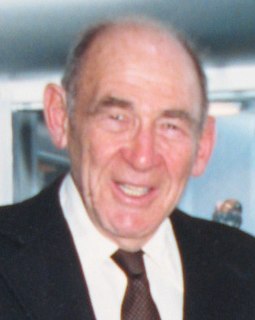
Arthur S. Iberall was an American physicist/hydrodynamicist and engineer who pioneered homeokinetics, the physics of complex, self-organizing systems. He was the originator of the concept of lines of non-extension on the human body which was used to create workable space suits.

Neutral buoyancy simulation with astronauts immersed in a neutral buoyancy pool, in pressure suits, can help to prepare astronauts for the difficult task of working while outside a spacecraft in an apparently weightless environment.
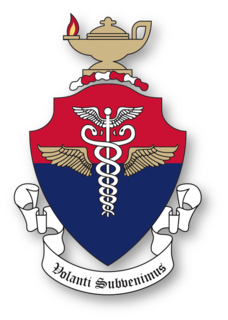
The United States Air Force School of Aerospace Medicine (USAFSAM) is the United States Air Force (USAF) organization focused on education, research, and operational consultation in aerospace and operational medicine. USAFSAM was founded in 1918 to conduct research into the medical and physiologic domains related to human flight, and as a school for medical officers trained to support military aviation operations, later coined as flight surgeons. The school supported early military aviation from World War I through the evolution of aviation and into the modern era. USAFSAM conducted medical research and provided medical support for the initial US space operations beginning in 1947 through the establishment of NASA in 1958. After the creation of NASA, USAFSAM continued to actively support civilian and military manned space missions through clinical and physiologic research. USAFSAM is one of the oldest continually operating school for flight surgeons and other operational medical personnel of its kind in the world. USAFSAM is located in Dayton, Ohio at Wright-Patterson Air Force Base, and is part of the 711th Human Performance Wing and the Air Force Research Laboratory (AFRL).

Locomotion in space includes any variety of actions or methods used to move one's body through an environment with microgravity conditions. Locomotion in these conditions is different from locomotion in Earth's gravity. There are many factors that contribute to these differences, and they are crucial when researching long-term survival of humans in space.

A Mars suit or Mars space suit is a space suit for EVAs on the planet Mars. Compared to a suit designed for space-walking in the near vacuum of low Earth orbit, Mars suits have a greater focus on actual walking and a need for abrasion resistance. Mars' surface gravity is 37.8% of Earth's, approximately 2.3 times that of the Moon, so weight is a significant concern, but there are fewer thermal demands compared to open space. At the surface the suits would contend with the atmosphere of Mars, which has a pressure of about 0.6 to 1 kilopascal. On the surface, radiation exposure is a concern, especially solar flare events, which can dramatically increase the amount of radiation over a short time.
References
- ↑ Jenkins, Dennis R. (2012). Dressing for Altitude: U.S. Aviation Pressure Suits, Wiley Post to Space Shuttle. US National Aeronautics and Space Administration. p. 241. ISBN 9780160901102.
- 1 2 Dava J. Newman (March 2005). "Astronaut Bio-Suit System for Exploration Class Missions" (PDF). Massachusetts Institute of Technology. Archived from the original (PDF) on 2010-06-13.
- ↑ Iberall, A.S., "The experimental design of a mobile pressure suit", Journal of Basic Engineering, Transactions of the ASME, June 1970, p. 251-264
- ↑ Iberall, A.S. (November 1964). "RAND Development Corporation Report AMRL-TR-64-118: The Use of Lines of Nonextension to Improve Mobility in Full-Pressure Suits" (PDF). Behavioral Sciences Laboratory, Aerospace Medical Research Laboratories, Aerospace Medical Division. Air Force Systems Command, Wright-Patterson Air Force Base, Ohio. Archived from the original (PDF) on August 26, 2014.
- ↑ Maggie McKee (17 July 2007). "Future spacesuits to act like a second skin". New Scientist.